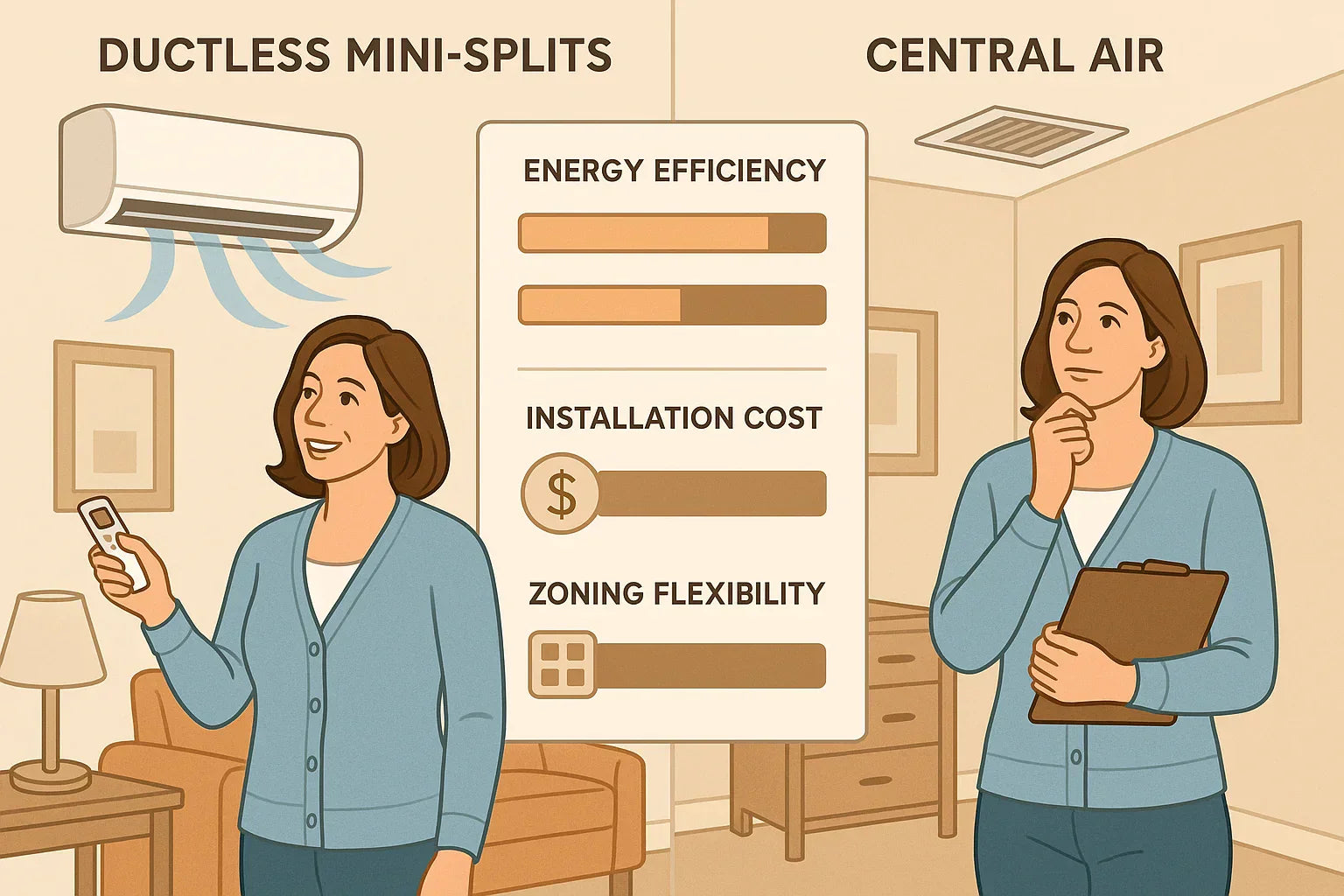🏡 Why Samantha Needs This Comparison
Choosing between a ductless mini-split system and central air conditioning is one of the most impactful decisions Samantha can make for her comfort, energy bills, and long-term home value.
This guide will help Samantha: ✅ Understand differences in installation, efficiency, and comfort. ✅ Compare upfront costs and long-term expenses. ✅ Decide based on her home’s structure and family’s lifestyle. ✅ Avoid regrets and ensure year-round comfort.
🛠️ Installation: Ductless vs. Central Air
Ductless Mini-Split Installation:
✅ No ductwork needed. ✅ Quicker install (1-2 days typical). ✅ Less invasive (small wall penetrations for line sets). ✅ Perfect for additions, older homes, and spot cooling.
Central Air Installation:
✅ Requires ductwork (adds cost if ducts are not present). ✅ Installation can take 3-7 days. ✅ Duct leaks can reduce system efficiency. ✅ Provides whole-home even cooling where ductwork exists.
Learn about ductless vs. central AC installation here.
💰 Upfront Costs: Which Is Cheaper?
| System | Typical Installed Cost |
|---|---|
| Ductless Mini-Split (Single-Zone) | $3,000 - $5,500 |
| Ductless Mini-Split (Multi-Zone) | $7,000 - $18,000 |
| Central Air (with existing ducts) | $5,000 - $10,000 |
| Central Air (new ducts needed) | $10,000 - $20,000+ |
If Samantha’s home lacks ductwork, a ductless system is typically less expensive than adding ducts for central air.
🌿 Energy Efficiency: SEER and Operating Costs
Ductless Mini-Splits:
✅ SEER ratings of 19-30+. ✅ No duct losses (duct leaks can account for 20-30% energy waste). ✅ Zoned cooling reduces unnecessary energy usage. ✅ Inverter compressors adjust output for demand.
Central Air:
✅ SEER ratings of 14-20 typically. ✅ Whole-home cooling even if only a few rooms are used. ✅ Efficiency impacted by duct condition and home insulation.
Explore SEER efficiency ratings here.
🌀 Comfort and Zoning Flexibility
Ductless Mini-Splits:
✅ Zoned cooling for individual rooms. ✅ Different rooms can have different temperatures. ✅ Ideal for homes with hot/cold spots. ✅ Quiet operation (as low as 19 decibels).
Central Air:
✅ Even cooling throughout the home. ✅ No visible indoor units. ✅ Zoning possible with additional equipment (adds cost). ✅ Slightly noisier (due to duct air movement).
🎨 Aesthetic Considerations
Ductless Mini-Splits:
🚩 Indoor air handlers visible on walls or ceilings. ✅ Slim, modern designs. ✅ Options like ceiling cassettes available.
Central Air:
✅ No visible indoor units; air comes through vents. ✅ Traditional, integrated look.
For Samantha, if appearance is critical, central air may be preferable unless she is comfortable with the minimal aesthetic of modern mini-splits.
🧼 Maintenance Differences
Ductless Mini-Splits:
✅ Monthly filter cleaning. ✅ Annual coil and system inspections. ✅ No duct cleaning required.
Central Air:
✅ Filter changes every 1-3 months. ✅ Duct inspections and cleaning recommended every 3-5 years. ✅ Coil cleaning and annual checkups.
Learn about ductless maintenance here.
📈 Long-Term Cost of Ownership
✅ Ductless systems often have lower operating costs due to higher efficiency and zoning. ✅ Central air may have lower maintenance costs in ducted homes but can waste energy cooling unoccupied spaces. ✅ Utility savings with ductless can offset the initial higher equipment cost over 5-10 years. ✅ Lifespan for both systems is 15-20 years with proper maintenance.
🏠 Best Use Cases for Samantha
✅ Choose Ductless Mini-Splits if:
-
Your home lacks ductwork.
-
You want zoned comfort for specific rooms.
-
You plan to retrofit an addition or garage.
-
You prioritize efficiency and lower utility bills.
✅ Choose Central Air if:
-
Your home already has well-designed ductwork.
-
You want whole-home even cooling.
-
You prefer a fully integrated, hidden system.
-
You have limited wall space for mini-split units.
🤔 Samantha’s Decision Checklist
✅ Do you have existing ducts in good condition? ✅ Do you prefer zoned or whole-home comfort? ✅ Is aesthetic appearance critical to you? ✅ Are you focused on maximum energy efficiency? ✅ Do you plan to cool/heat specific areas more often?
Answering these questions will guide Samantha to the best option for her comfort and lifestyle.
🛡️ Rebates and Incentives
Both ductless mini-splits and high-efficiency central air systems may qualify for: ✅ Federal tax credits. ✅ Local utility rebates. ✅ Manufacturer incentives.
Check potential savings using DSIRE.
✅ Conclusion: Which Is Better for Samantha?
There is no one-size-fits-all answer. Samantha should choose:
✅ Ductless Mini-Splits if she values zoned comfort, energy efficiency, and installation flexibility without ducts.
✅ Central Air if she values whole-home cooling with an integrated, hidden appearance and already has ductwork in place.
Both systems can offer excellent comfort and efficiency when chosen based on your home’s needs.
📲 Ready to Explore Ductless Mini-Splits?
View our Ductless Mini-Splits Collection to find systems that match your comfort, efficiency, and budget goals.
In the next topic we will read more about: Energy Efficiency and Tax Credits: Do Ductless Mini-Splits Qualify?







